Kamegayatsuzaka Kiridoshi Pass (亀谷坂切通)
|
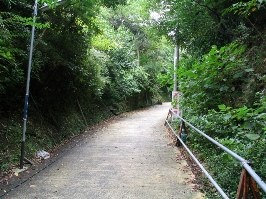
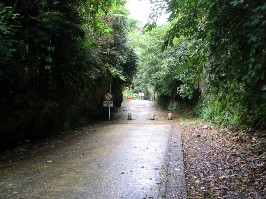
Location: 1.5 kilometers north from JR Kamakura Station.
Site: This pass connects the busy shopping streets around JR
Kamakura Station and the Kita-Kamakura area, where Engakuji, Tokeiji,
and Kenchoji Temples are located. Many sightseers take this pass to
access to the central part of the city after visiting the Kika-Kamakura
area. They would enjoy an overshadowed quiet atmosphere.
The slope was once one of the seven passes in
old Kamakura and is now designated a Historic Site by the government.
Story: The steepness of the slope has given rise to a
story about a turtle around here. One day it tried
to climb the slope to see what was like on the other side.
Gradually it became aware that the slope was too steep and finally
turned around and gave up. Thus the slope came to be called
Kamekaerisaka, "Turtle-Return-Slope," which, over the years, gradually
corrupted into Kamegayatsuzaka.
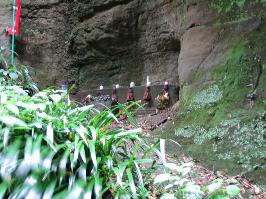
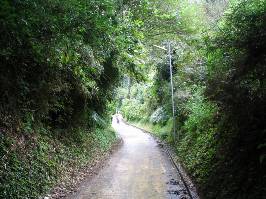
|
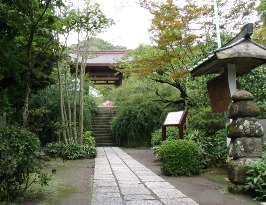
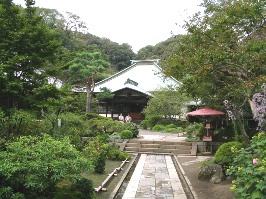
Full name: Senkokusan Kaizoji (扇谷山海蔵寺)
Denomination: Rinzai Zen sect (臨済宗)
Location: 1.5 kilometers north from JR Kamakura Station
History: The temple originally belonged to the Shingon
sect. Fujiwara no Nakayoshi (藤原仲能) had the temple built in 1253
at the request of Prince Munetaka (宗尊親王, 1242-74), the sixth shogun in
Kamakura.
In 1333, all the buildings went up in flames,
victimized by the battle between the Kamakura bakufu and the imperial
forces, ending in the downfall of the Kamakura government.
In 1394, Uesugi Ujisada (上杉氏定) rebuilt the
temple by order of the second Kamakura kubo, Ashikaga Ujimitsu (足利氏満,
1359-98). This time the temple was converted to a Zen temple, inviting
Genno Zenji (源翁禅師, 1329-1400), also known as Shinsho Kugai 心昭空外, to be
the founding priest.
From that time onward, Kaizoji Temple prospered under the patronage of the Ogigayatsu Uesugi family. Since 1577, it has been affiliated with Kenchoji Temple.
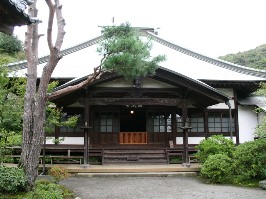
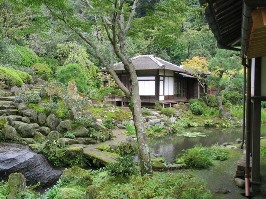
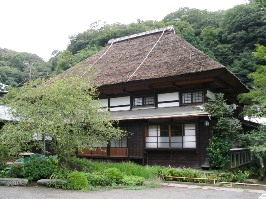
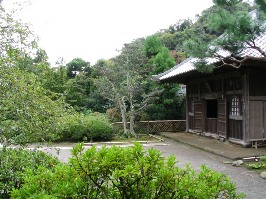
Grounds and structures: Beyond the Sammon Gate are a
belfry, the Kuri (the priest's living quarters), and the Main Hall. On
the left side of the grounds is Yakushido Hall (薬師堂, also called
Butsuden).
The Main Hall, called Ryugoden (龍護殿), was
reconstructed after the Great Kanto Earthquake of 1923. The hall houses
a seated image of Shinsho Kugai, the founding priest, a bronze image of
Shakyamuni, allegedly brought from Thailand, and a standing image of an
eleven-faced Kannon (十一面観音). The paper sliding doors of the hall are
adorned with paintings of dragons, Chinese lions, and peonies.
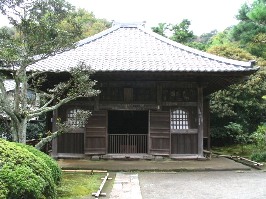
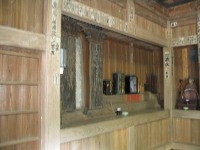
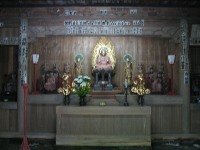
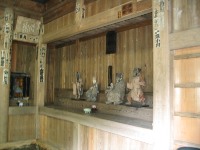
Yakushido Hall, transferred here from Jochiji
Temple (浄智寺) in 1776, houses Yakushi Nyorai (薬師如来), the main image, and
two attendants, Nikko Bosatsu (日光菩薩) and Gakko Bosatsu (月光菩薩). Behind
them are Juni Shinsho (十二神将, Twelve Guardian Generals), who stand in
one column of six on either side of the main Buddha, acting as
protectors. Also in the hall are statues of Garanshin (伽藍神), a temple
protector, Daruma Daishi (達磨大師), and Kobo Daishi (弘法大師).
The main image, Yakushi Nyorai, is popularly
called Naki Yakushi (啼薬師, "Weeping Yakushi") or Komori Yakushi (児護薬師,
"Child-guarding Yakushi"). The feature of this image is that it
contains within its body an old wooden Buddhist head. The story dates
back to the time when Kugai (空外), the first priest, resided here.
The weeping of a baby could be heard every
night behind the temple buildings. He sought the source of this crying
and noticed that it was coming from beneath a gravestone. He chanted a
sutra as an offering, and the crying stopped, suddenly and forever. The
next day he dug up the grave and found the head portion of Yakushi
Nyorai. He then carved a new image of Yakushi large enough to hold the
unearthed head within its body. Close inspection will reveal a small
door fixed with two hinges on the statue's breast. Even today this
Nyorai is popularly held to be a guardian of children's happiness and
healthy growth.
On the left altar are two large and old
mortuary tablets. Both were made in memory of the people who
contributed to this temple, one tablet in 1423, the other in
1515. Such tall tablets are rare and seen
only here in Kamakura.
Along the cliff to the left of the main hall
are four caves. The third one contains an image of Ugajin (宇賀神) or
Ugafukujin (宇賀福神) as an old man with a snake coiled around his body.
Ugajin gives happiness to believers and is associated with the harvest
and food in general.
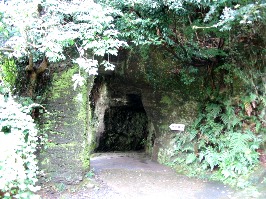
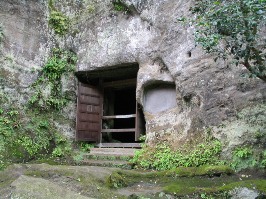
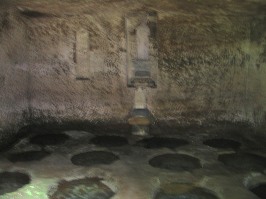
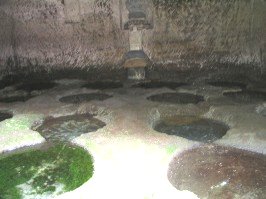
To the left of Yakushido Hall is a footpath.
Fifty meters further on and to the right is a cliff-side cave, four
meters wide and deep, and three meters high. The well inside the cave
is called Juroku no I Well (十六ノ井), literally the Sixteen-Well and is said to have been dug by the celebrated priest, Kobo Daishi (弘法
大師, 774-835), the founder of the Shingon sect of Buddhism in Japan.
There are 16 round, shallow holes filled with
clear water, four in each of the four rows. Following a series of
natural disasters that buried the well, it was lost from memory until
Kugai became a priest here at Kaizoji. He remove the piled-up earth and
sand from the cave and clean the holes, pure water would again fill
them. It has been flowing ever since, even in the dry summer season,
and has helped countless numbers of sufferers, making the local people
highly grateful for its curative powers. The rear wall of the
cave has a small stone image of Kannon, in front of which stands a
small image of Kobo Daishi. To the left of Kannon is a vertical
recess which once held a stone tablet carved with an image of
Amida-sanzon-raigo-zu (阿弥陀三尊来迎図) depicting Amida and an attendant
Bosatsu as they descend to welcome a believer on his deathbed.
The tablet is now on loan to the Kamakura
Kokuhokan. Because it is inscribed with an era name, 嘉元四年,
(corresponding to the year 1306), it is very rare. The tablet's
well-formed design and the inscription
identifying the era of its creation are factors that make it a remarkable example of this kind of work.
|
Sokonuke no I Well (底脱ノ井)
|
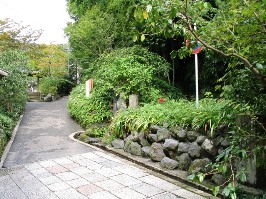
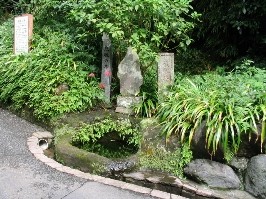 Location: To the right of the entrance to Kaizoji Temple.
Location: To the right of the entrance to Kaizoji Temple.
Story: This well was one of the ten wells in old Kamakura.
Although the term sokonuke, meaning "bottomless" or
"no bottom", is attached to this well, the name was originally in
reference to a bucket, as the following story shows.
The story had its beginning in the Muromachi period
when a lady of the Uesugi family became a helper at this temple.
One day when she tried to dip water from this well, the bottom of the
pail dropped out. Immediately her spiritual darkness that had long been
hanging in her mind disappeared. She is said to have
even attained enlightenment.
A similar story is told about another lady, Chiyono
(千代能), a daughter of Adachi Yasumori (安達泰盛, 1231-85), a warrior in the
middle Kamakura period.
|
|
Kewaizaka Slope (仮粧坂, or Keshozaka)
|
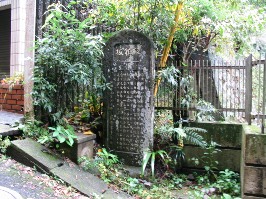
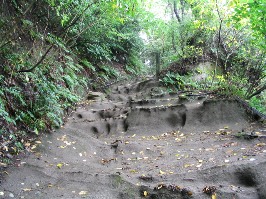
Location: Two kilometers north from JR Kamakura Station.
Origin of the name: The part of the slope's name, kewai or
kesho, means "makeup" or "made up." One explanation about the origin of
the name is that the face of a general of the Taira clan was "made up"
here prior to the identification of his body in order to conceal the
disfigurement caused by his death. (Refer to the next "History.")
Another explanation is that the area here was once a
rather busy one where many women, heavily made up (kesho), worked to
entertain pleasure-seeking men.
History: The slope was one of the seven passes in old
Kamakura and is now designated a Historic Site by the government.
In olden times, this slope was very important, leading as it did to
Musashi (武蔵) via Fujisawa (藤沢).
When the army of Nitta Yoshisada (新田義貞, 1301-38)
attacked Kamakura in 1333, he assigned his main forces to this area. A
fierce battle between the Nitta and the Hojo was undoubtedly fought in
the vicinity.
A stone monument at the foot of the slope
provides further information about Kewaizaka's history. The area
preserves the atmosphere of olden times.
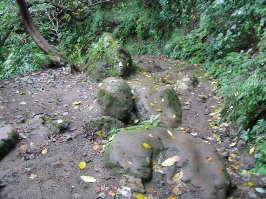
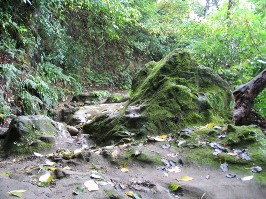
|
|
Genjiyama Koen Park (源氏山公園)
|
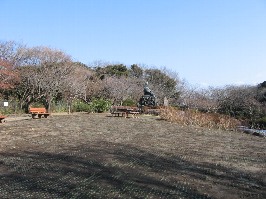
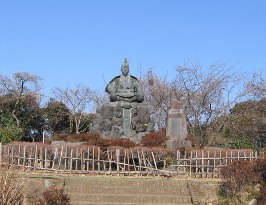
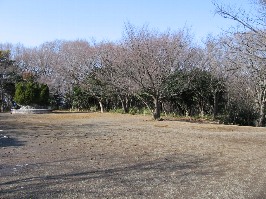
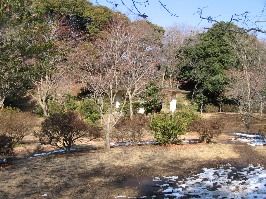
Location: On a hill above Jufukuji and Eishoji Temples.
History: This hill came to be called Genji Yama, or
Hatatate Yama (旗立山), "Flag-Raising Hill," because it was here that
Hachiman Taro Yoshiie (八幡太郎義家, 1039-1106) raised a white flag, the
symbol of his Genji family. He prayed for victory before starting for
the northern part of the country in 1083 in the Gosannen no Eki
(後三年の役), Later Three Year War (1083-87).
The park was constructed in 1965 and became a
popular spot for flower viewers. A two-meter-tall statue of a
dignified-looking Minamoto no Yoritomo (源頼朝, 1147-99) stands within it.
This was erected as one of the events commemorating the 800th
anniversary of the beginning of the Kamakura bakufu.
|
|
The Grave of Hino Toshimoto (日野俊基の墓)
|
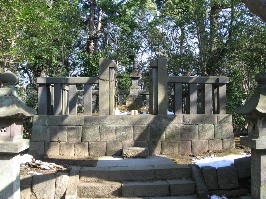
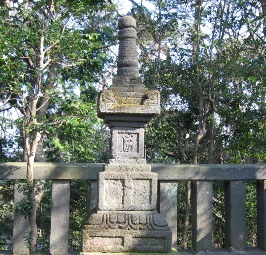
Location:
In the Genjiyama Koen Park.
History: Toshimoto (日野俊基, ?-1332) was a court noble
under Emperor Go-Daigo (後醍醐天皇, 1288-1339), who plotted to the downfall
of the Kamakura bakufu. The head of the then military government was
Hojo Takatoki (北条高時, 1303-33). He was once arrested when the plot
leaked out beforehand, but he was released. In the second
attempt, he was arrested again, and sent here to Kamakura for execution
at Kuzaharagaoka. After the death sentence was passed, his wife
asked one of his men to take a message to her confined husband.
This was difficult mission to carry out. Finally, on the very day of
the execution he made a desperate dash up to the executioners who were
heading for the execution site taking Toshimoto. He petitioned the
guard for permission to meet his master. The guard, moved by his
sincere behavior, is said to have permitted him to hand Toshimoto his
wife's message.
A year after Toshimoto's death, the hopes he'd held
in life were realized when, on May 22, in 1333, the major forces of
Nitta Yoshisada broke through the defenses here, rushed into the center
of the city and overthrew the bakufu.
The tomb: A stone fence surrounds an old hokyointo-type stupa
claimed to be for Hino Toshimoto (日野俊基, ?-1332).
This area is designated a Historic Site by the government.
|
|
|
|
Kuzaharagaoka Jinja Shrine (葛原岡神社)
|
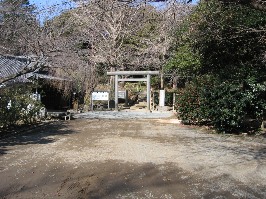
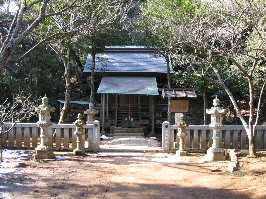
Location: In the Genjiyama Park.
Grounds: A simple structure called Kuzuharagaoka Jinja
Shrine (葛原ケ岡神社), is dedicated to Toshimoto and stands on the far side
of the open space. Built in 1887, the shrine now acts as a
guardian of the Yuigahama (由比ガ浜) area. To the left of the second
torii are the shrine office and a repository for a portable shrine.
Zeniarai Benzaiten Ugafuku Jinja Shrine (銭洗弁財(才)天宇賀福神社, more popularly, Zeniarai Benten, 銭洗弁天)
|
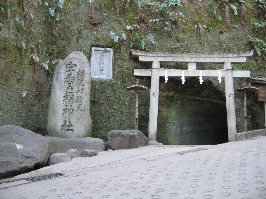
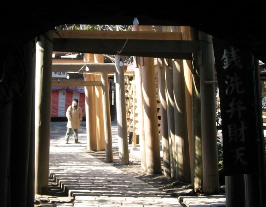
Location: 1.5 kilometers north-west from JR Kamakura Station.
Enshrined deity: Ugafukujin (宇賀福神)
Zeniarai Benten, literally, "Money-Washing Benten," is famous for its
miraculous power that adds to a worshipper's money if it is dipped in
the water here; hence Zeniarai (銭洗), "Money-Washing-Water." (In
old Kamakura, the water here was counted as one of the five sources of
pure water.)
Today, many people visit especially on the day of the Snake ("Mi," 巳), which is connected with Ugafukujin. Because the body of this deity is generally in the form of a coiled snake with
the face of an old man or lady, and it is responsible for the power of
this water.
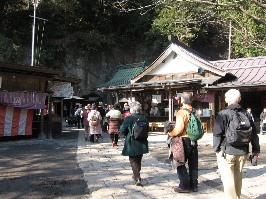
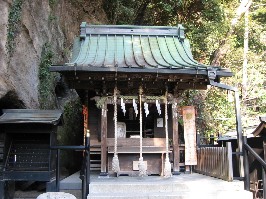
Story: In olden days and even now, enclosed by cliffs,
this spot was called Kakuresato (隠里), literally, "Hidden Hamlet."
To the right at the end of the tunnel of torii is the Main Hall, and
further to the left is the cave where Benzaiten is enshrined.
History: Minamoto no Yoritomo (1147-99), the first Shogun
of the Kamakura government, prayed daily and nightly for peace and
order in the country. One day, on a day of the Snake in the year
of the Snake, an old man appeared to Yoritomo in a dream. He said,
"Your concern for the people and sincerity have impressed me
greatly. Behold, I will show you a secret that will bring peace
and prosperity to your country. To the northwest lies a valley where
pure water runs from among the rocks. It is a holy spring. Make an
offering of its water to the deities whenever you pray." The old man
disappeared, saying "I am Ugafukujin, god of
this secret hamlet."
Upon awakening, Yoritomo immediately sent his men to find the spring
that had been revealed to him. When the party eventually located a
spot, Yoritomo ordered a cave dug and a shrine built, which he then
dedicated to Ugafukujin. Further Yoritomo ordered his men to carry
water from the spring to his residence and offer it to the deities. The
realm, it is said, soon knew peace, wrongdoings disappeared, and people
enjoyed their lives.
In 1257, Hojo Tokiyori (北条時頼, 1227-63), the fifth
regent, revived a tradition that Yoritomo had established and created a
new practice: if a person dipped money into the water to purify it, it
would then become money of good fortune and the family would prosper.
People rushed here, and once they dipped their money in the water, it
would always bring more. Thus, in the course of time, the waters here
came to be called Zeniarai no Mizu, and the well came to be counted as
one of the five sources of pure water in old Kamakura.
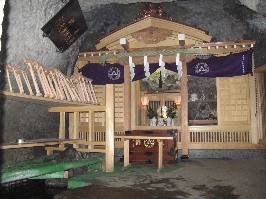
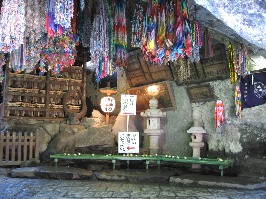
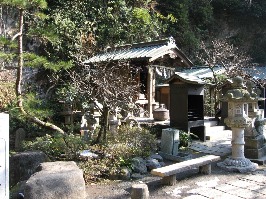
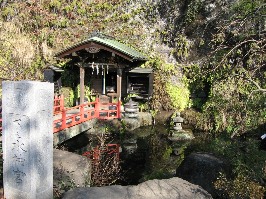
Grounds and structures: On the right of the slope down
from Genjiyama Park is a shrine gate, torii, and a small tunnel in the
cliff. At its end is another "tunnel" of several score of red torii
donated by the faithful. The grounds contain not only the Main
Hall and the cave, but a shrine office and a number of shrines, Kami no
Mizusha Shrine (上の水社), Shimo no Mizusha Shrine (下の水社), and some related
shrines in addition to refreshment stands and bench areas.
Recently, a cave was found above the tunnel, the
main entrance to the precincts. Relics found inside include a stone
tablet bearing a Sanskrit character that symbolizes the Shakasanzon and
the year name 正和元年 (corresponding to 1312), and a gorinto-type stupa
bearing the year name 元徳二年 (corresponding to 1330). The items are
now preserved in the Kamakura Kokuhokan within the grounds of
Tsurugaoka Hachimangu Shrine.
|
Sasuke Inari Jinja Shrine (佐助稲荷神社)
|
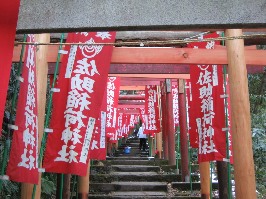
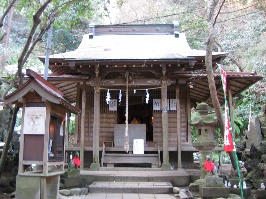
Location: 1.5 kilometers northwest from JR Kamakura Station.
Enshrined deity: Inari, the god of the harvest
Story: There is a story surrounding the founding of the
shrine. It says that when Minamoto no Yoritomo was in exile in Izu, he
fell ill and had a dream in which an old man appeared to him. In his
hand the man held some herbs and, showing them to Yoritomo, said, "Make
these into a medicine, take it, and you will be cured. Upon recovery,
immediately take up arms against the Taira. Victory will be
yours." Yoritomo asked the man his name and he replied, "I am the
god of the hidden hamlet in Kamakura," then vanished.
Yoritomo succeeded in establishing his government and believed the
success was due to the advice of the old man. He later ordered his men
to search for the abode of the god, and in Kamakura, west of the hidden
hamlet they found a shrine. Yoritomo immediately replaced the old
shrine with a newly-built one and named it Sasuke Inari.
The sa (佐) in Sasuke was part of the name Yoritomo held in his youth, 佐殿
(but
pronounced sukedono). The suke in Sasuke means "to help." Thus,
the name "Sasuke" was used as the name of this shrine because "Sukedono
was helped by a god."
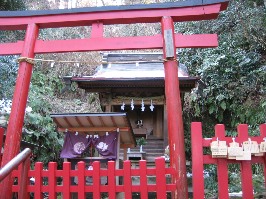
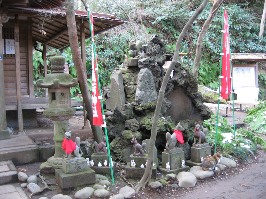
Grounds and structures: Surrounded by tall trees, the grounds
are rather dark even in the daytime. Sasuke Inari Jinja Shrine, a
rather simple structure, sits at the top of a steep stone stairway.
Behind it is another flight of stone steps, leading to the inner
shrine.
|
|